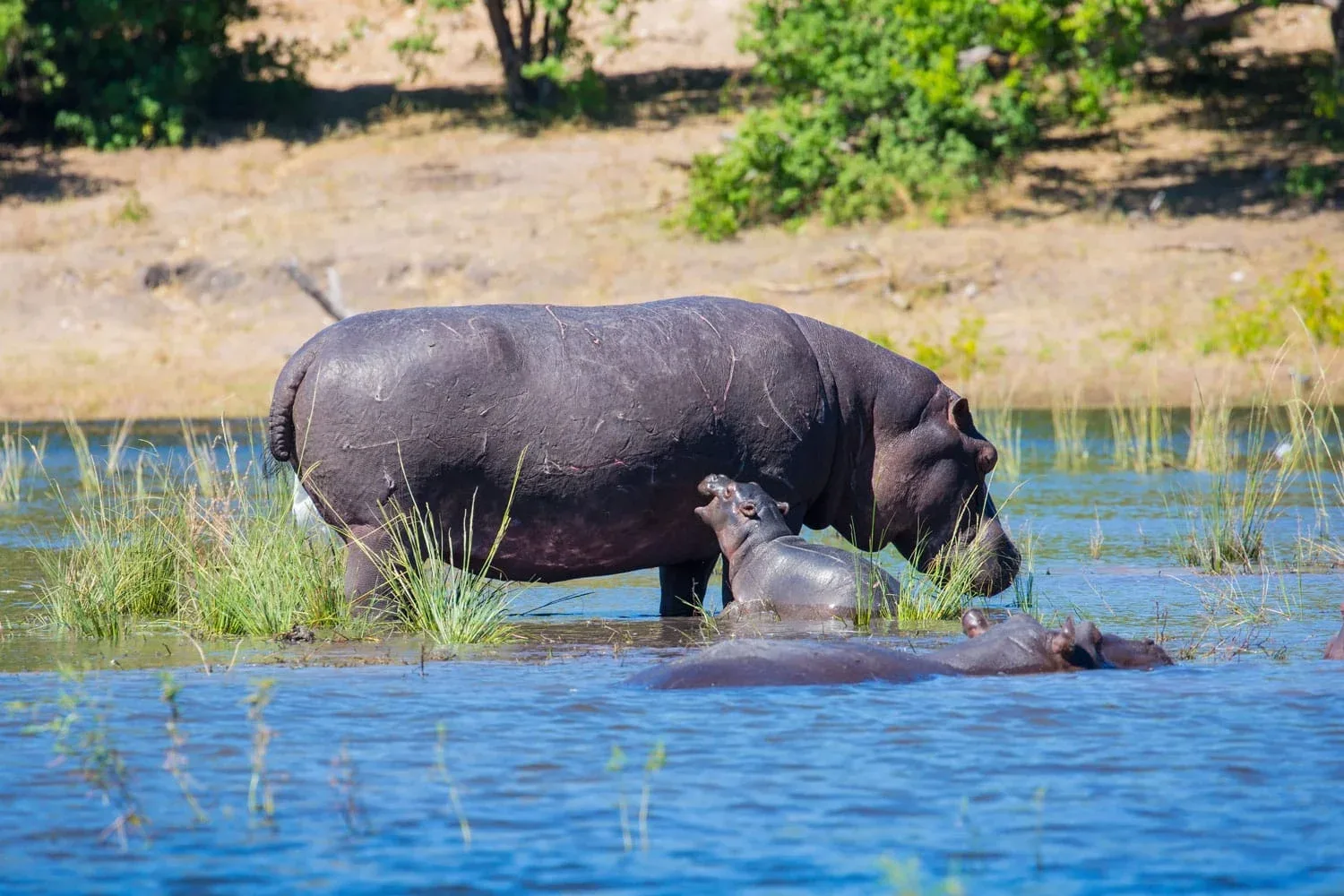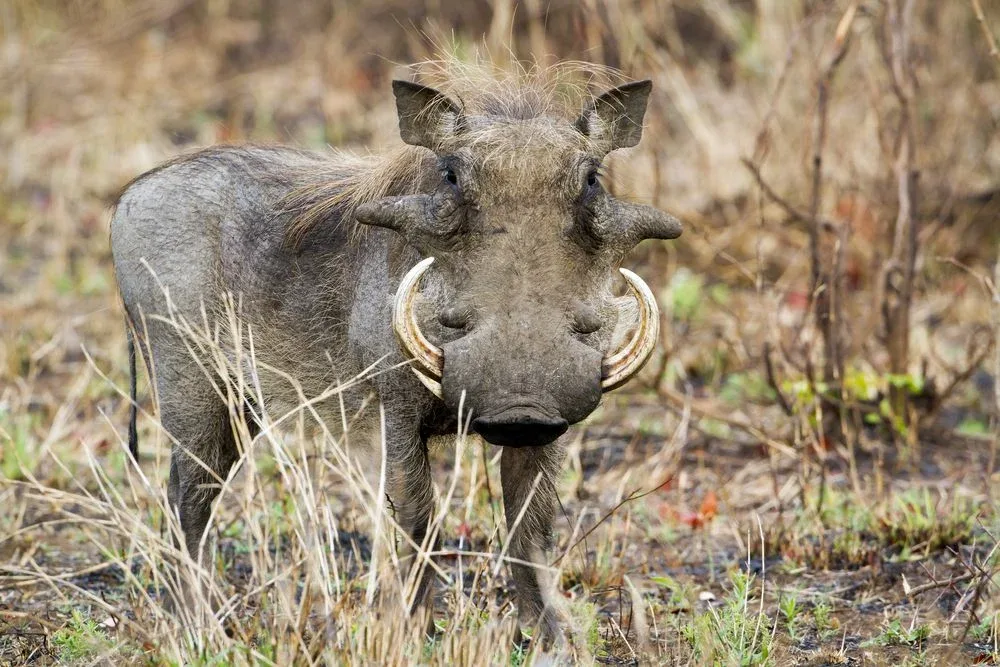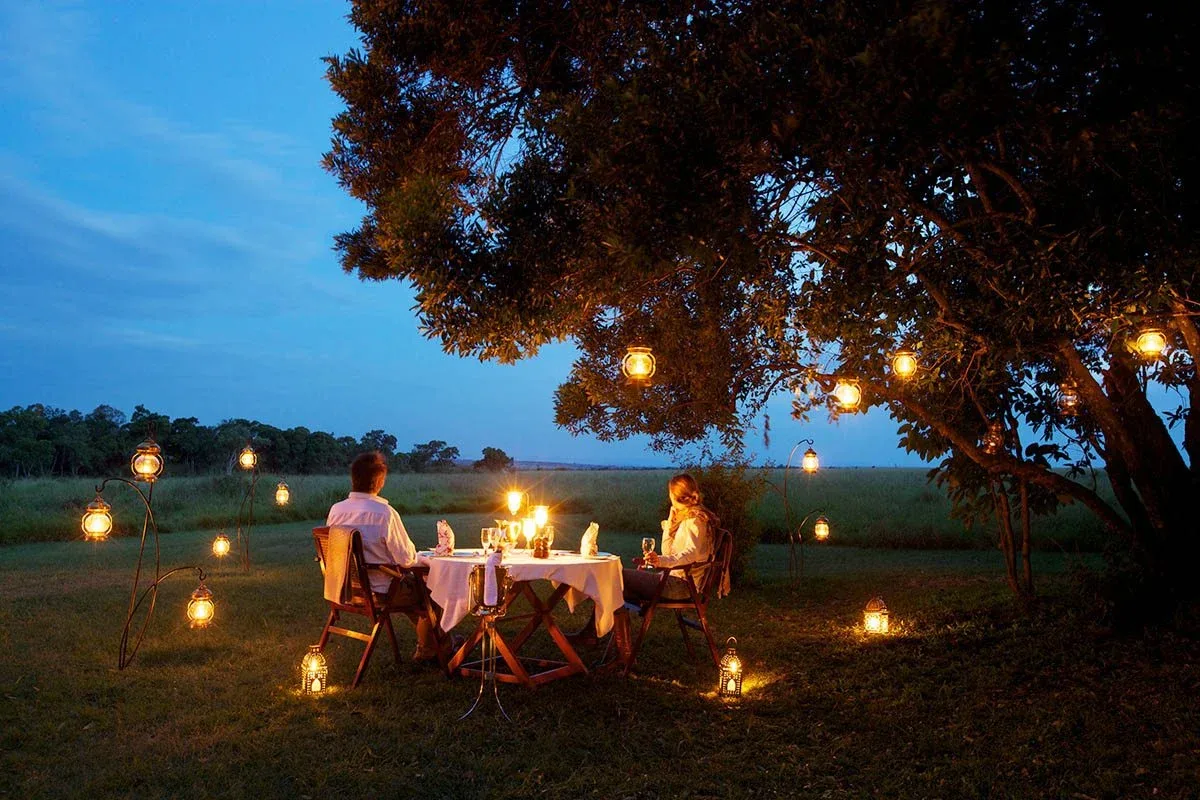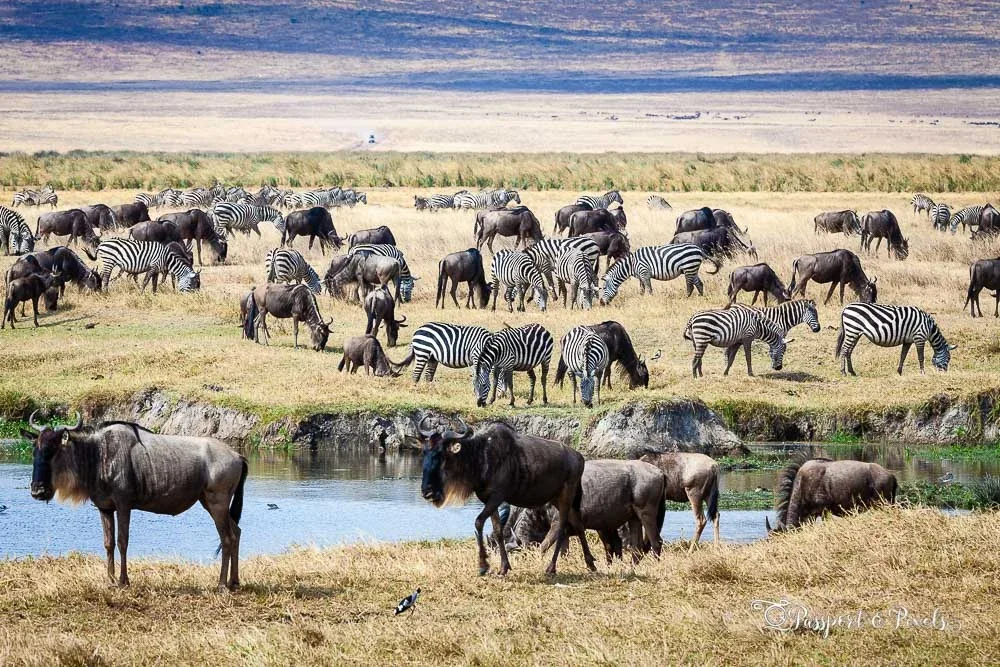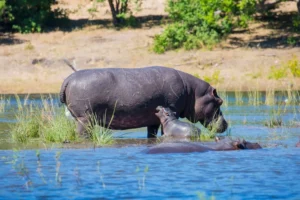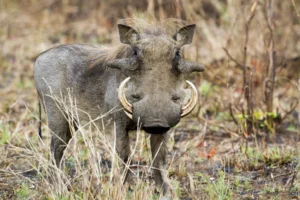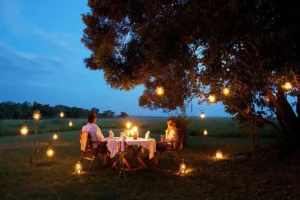Explore the differences between Kenya Vs Tanzania safaris to determine which offers the best African safari experience for you. Compare wildlife diversity, landscapes, cultural encounters, and safari accommodations in these iconic East African destinations.
Getting on an African safari is a dream for many travelers seeking to witness the continent’s iconic wildlife and stunning landscapes. When it comes to choosing between Kenya and Tanzania for an unforgettable safari experience, both countries offer unique attractions and safari opportunities. Let’s delve into the comparison to help you decide which destination aligns best with your safari expectations and preferences.
Kenya Vs Tanzania Safari: Geographical Location and Landscape

Kenya and Tanzania, are two iconic destinations in East Africa, renowned worldwide for their spectacular wildlife and rich safari experiences. Situated in close proximity to each other, these countries offer diverse landscapes and unique wildlife encounters, attracting nature enthusiasts and adventure seekers from around the globe. Let’s delve into the geographical locations and landscapes of Kenya and Tanzania to understand their distinct offerings for safaris and wildlife exploration.
Geographical Location and Landscape Comparison:
Kenya is located on the eastern coast of Africa, it shares borders with Ethiopia, Somalia, Tanzania, Uganda, and South Sudan. On landscape diversity, Kenya boasts a diverse range of landscapes, including savannah grasslands, arid deserts like the Chalbi Desert in the north, lush forests, and scenic highlands such as the Aberdare Range and Mount Kenya. Besides, the Great Rift Valley runs through Kenya, offering stunning panoramas and unique geological features. This varied terrain supports a wide array of wildlife species, including the Big Five (elephant, rhino, lion, leopard, buffalo) and numerous bird species.
On the other hand, Tanzania is situated south of Kenya, sharing borders with Kenya, Uganda, Rwanda, Burundi, Zambia, Malawi, Mozambique, and the Democratic Republic of Congo. Its landscape diversity is characterized by vast plains, rolling savannahs, mountain ranges, and coastal regions along the Indian Ocean. It is home to Africa’s highest peak, Mount Kilimanjaro, and the iconic Ngorongoro Crater, a volcanic caldera teeming with wildlife. The Serengeti National Park, famous for the Great Migration of wildebeest and zebras, showcases Tanzania’s expansive grasslands and diverse ecosystems, while parks like Tarangire and Selous offer distinct habitats and abundant wildlife sightings.
In conclusion, both Kenya and Tanzania offer exceptional safari experiences and incredible wildlife diversity due to their varied landscapes and conservation efforts. While Kenya’s Great Rift Valley and iconic Masai Mara National Reserve are renowned worldwide, Tanzania’s Serengeti, Ngorongoro Crater, and Mount Kilimanjaro stand as symbols of Africa’s natural beauty and wildlife wonders. Whether you choose to explore Kenya’s savannahs or Tanzania’s vast plains, a safari in either country promises unforgettable adventures and close encounters with Africa’s magnificent wildlife.
Here’s a comparison between Kenya and Tanzania based on various aspects:
| Aspect | Kenya | Tanzania |
| Official Capital City | Nairobi | Dodoma (legislative capital), Dar es Salaam (executive capital) |
| National Languages | Swahili, English | Swahili, English |
| Safari Capital | Masai Mara National Reserve, Amboseli National Park, Tsavo National Park | Serengeti National Park, Ngorongoro Conservation Area, Tarangire National Park |
| Major National Conservation Areas | Masai Mara National Reserve, Amboseli National Park, Tsavo National Park, Aberdare National Park, Mount Kenya National Park | Serengeti National Park, Ngorongoro Conservation Area, Tarangire National Park, Selous Game Reserve, Ruaha National Park |
| Private Conservation Areas | Lewa Wildlife Conservancy, Ol Pejeta Conservancy, Olare Motorogi Conservancy | Grumeti Reserves, Singita Grumeti Reserves, Manyara Ranch Conservancy |
| Off-the-Beaten-Path Reserves | Samburu National Reserve, Laikipia Plateau, Meru National Park | Katavi National Park, Mahale Mountains National Park, Ruaha National Park |
| Beaches & Islands | Diani Beach, Lamu Island, Watamu Beach | Zanzibar Island, Pemba Island, Mafia Island |
| Most Popular Routes | Nairobi – Masai Mara – Lake Nakuru – Amboseli – Tsavo – Nairobi | Arusha – Serengeti – Ngorongoro Crater – Lake Manyara – Tarangire – Arusha |
These points provide a snapshot of some key aspects related to each country’s tourism and conservation areas. Kenya and Tanzania both offer rich biodiversity, stunning landscapes, and a plethora of wildlife experiences, making them top destinations for travelers interested in safaris and nature exploration in Africa.
Masai Mara National Reserve -Kenya VS Serengeti National Park, Tanzania
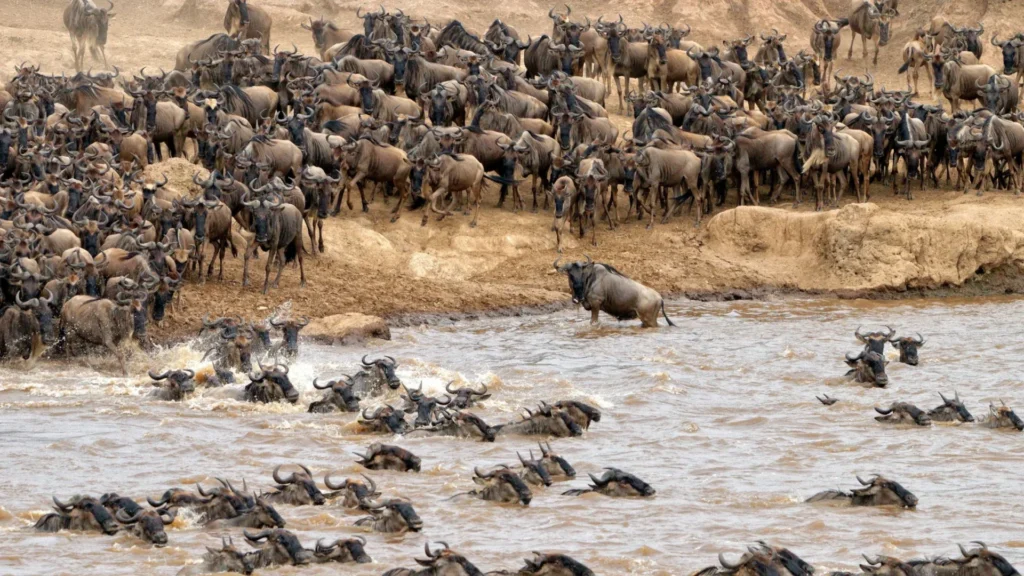
The Masai Mara National Reserve in Kenya and Serengeti National Park in Tanzania are two iconic safari destinations renowned for their wildlife spectacles and natural beauty. Both parks are part of the greater Serengeti-Mara ecosystem, offering visitors an incredible opportunity to witness the Great Migration of wildebeest and zebras, along with diverse wildlife experiences.
| Aspect | Masai Mara National Reserve (Kenya) | Serengeti National Park (Tanzania) |
| Geographical Location | Located in southwestern Kenya, contiguous with the Tanzanian | Situated in northern Tanzania, extending into southwestern |
| border, forming part of the greater Serengeti ecosystem. | Kenya. | |
| Size | Covers an area of about 1,510 square kilometers. | Encompasses around 14,750 square kilometers. |
| Wildlife Diversity | Famous for the Great Migration, featuring large herds of | Renowned for the Great Migration, with millions of wildebeest, |
| wildebeest, zebras, and other grazers. | zebras, and gazelles crossing from Serengeti to Masai Mara. | |
| Home to the Big Five (lion, leopard, elephant, buffalo, rhino). | Abundance of predators such as lions, cheetahs, leopards. | |
| Landscape | Characterized by vast savannah plains, acacia trees, and the | Known for vast grasslands, open plains, kopjes (rocky |
| Mara River running through the reserve. | outcrops), and woodland areas. | |
| Activities | Game drives, hot air balloon safaris, walking safaris, | Game drives, hot air balloon safaris, bush walks, cultural |
| cultural visits to Maasai villages, nature walks. | experiences, photography tours. | |
| Crowds | Generally, a popular and busy safari destination, especially | Can be crowded during peak seasons like the Great Migration, |
| during the Great Migration (July to October). | but offers vast areas for secluded wildlife viewing. | |
| Accessibility | Well-connected by road and air, with regular flights from | Accessible by road from various entry points and airstrips. |
| Nairobi and other major cities. |
In summary, while Masai Mara and Serengeti share similarities in terms of wildlife diversity and the Great Migration phenomenon, they also offer distinct experiences shaped by their landscapes, activities, and visitor accessibility. Whether you choose Masai Mara for its Mara River crossings during the migration or Serengeti for its vast plains and predator sightings, both parks guarantee an unforgettable safari experience in the heart of East Africa’s wilderness.
Kenya VS Tanzania Safari: Infrastructure and Logistics.
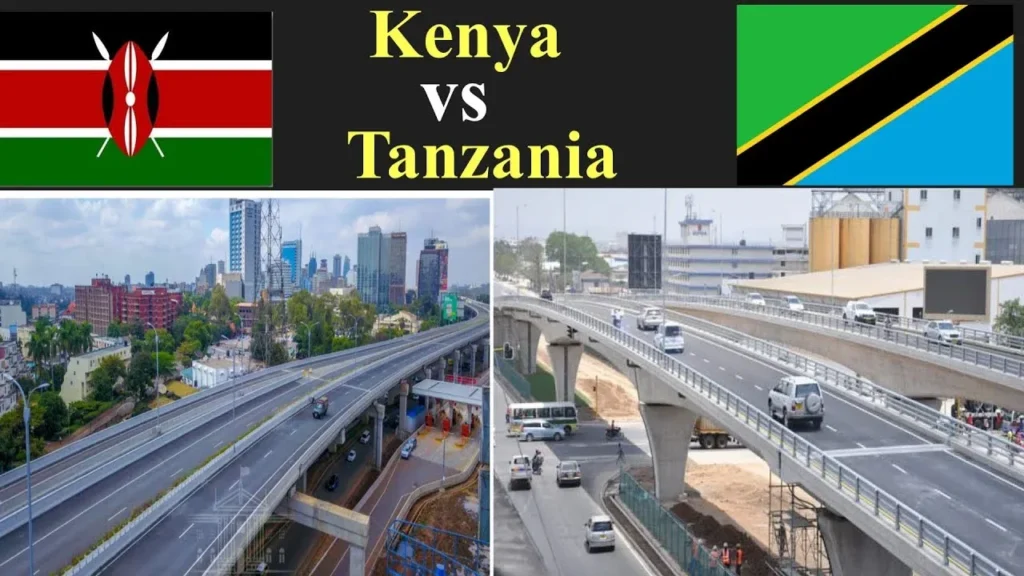
Kenya and Tanzania are renowned safari destinations in East Africa, attracting tourists from all over the world to witness their rich wildlife and natural beauty. Let’s compare and contrast the safari infrastructure and logistics of these two countries, focusing on aspects such as accommodation options, transportation, park management, and overall safari experience.
| Aspect | Kenya | Tanzania |
| Accommodation | Offers a range of accommodation options, | Provides diverse choices from luxury lodges |
| from luxury lodges and tented camps to | and tented camps to budget-friendly camps | |
| budget-friendly campsites inside and | and lodges, both inside and outside park | |
| outside national parks and reserves. | boundaries. | |
| Transportation | Well-developed road networks connecting | Extensive network of roads and air travel, |
| major parks and cities. Air travel is | with domestic flights between major cities | |
| common for longer distances, with | and airstrips near national parks for easy | |
| scheduled flights and charter options. | access to safari destinations. | |
| Park Management | Multiple agencies manage national parks | National parks and reserves are overseen |
| and reserves, with Kenya Wildlife Service | by Tanzania National Parks Authority (TANAPA) | |
| (KWS) being the primary authority. | and Ngorongoro Conservation Area Authority | |
| (NCAA), ensuring conservation and wildlife | ||
| protection. | ||
| Safari Experience | Offers a variety of safari experiences, | Provides diverse safari experiences, |
| including game drives, walking safaris, | such as game drives, walking safaris, | |
| hot air balloon safaris, and cultural | balloon safaris, cultural visits to local | |
| interactions with Maasai communities. | tribes, and boat safaris in some areas. | |
| Tourist Numbers | Generally receives a higher number of | Attracts a significant number of tourists, |
| tourists due to iconic parks like Masai | especially around iconic parks like | |
| Mara and Amboseli, leading to more | Serengeti and Ngorongoro, but manages | |
| crowded safari experiences during peak | tourist numbers well to avoid overcrowding. | |
| seasons. |
In conclusion, both Kenya and Tanzania offer well-developed safari infrastructures and logistics to cater to the diverse needs of visitors. While Kenya’s safari experience is characterized by iconic parks like Masai Mara and Amboseli, Tanzania boasts world-renowned destinations such as Serengeti and Ngorongoro. The choice between the two countries depends on personal preferences regarding accommodation, transportation, park management styles, and the desired safari experience, ensuring an unforgettable adventure in the heart of Africa’s wilderness.
Kenya VS Tanzania Safari Cost

When planning a safari in Africa, understanding the cost differences between Kenya and Tanzania is crucial. Let’s compare and contrast the safari costs in both countries, focusing on accommodations ranging from 4-star comfort to 5-star luxury during low and high seasons.
Kenya Safari Costs:
| Accommodation | Low Season (USD) | High Season (USD) |
| 4-Star Comfort | $250 – $350 | $400 – $600 |
| 4-Star Luxury | $400 – $600 | $600 – $900 |
| 5-Star Luxury | $600 – $900 | $900 – $1500 |
Tanzania Safari Costs:
| Accommodation | Low Season (USD) | High Season (USD) |
| 4-Star Comfort | $300 – $400 | $500 – $700 |
| 4-Star Luxury | $500 – $800 | $800 – $1200 |
| 5-Star Luxury | $800 – $1200 | $1200 – $2000 |
Combined Kenya & Tanzania Safari Costs:
| Accommodation | Low Season (USD) | High Season (USD) |
| 4-Star Comfort | $550 – $750 | $900 – $1300 |
| 4-Star Luxury | $900 – $1400 | $1400 – $2100 |
| 5-Star Luxury | $1400 – $2100 | $2100 – $3500 |
Comparison:
- 4-Star Comfort: Tanzania generally has slightly higher costs compared to Kenya in both low and high seasons.
- 4-Star Luxury: Costs are similar between the two countries, with Kenya’s high season rates slightly lower than Tanzania’s.
- 5-Star Luxury: Both countries offer luxurious experiences, but Tanzania’s high-end lodges and camps may have higher rates during peak seasons.
Overall, while there are cost variations between Kenya and Tanzania, especially in high season and in higher-end accommodations, combining both countries for a safari can provide a diverse and enriching experience. The choice ultimately depends on personal preferences, budget considerations, and the specific safari experiences and locations you wish to explore.
Kenya VS Tanzania Safari Beaches

Kenya and Tanzania both offer stunning safari beach experiences along their respective coastlines. Let’s compare and contrast the safari beaches of Kenya and Tanzania based on accessibility, activities, accommodation, and crowds.
| Aspect | Kenya Safari Beaches | Tanzania Safari Beaches |
| Accessibility | Easily accessible from major cities like Nairobi, with good road and air connections. | Accessible via flights to Zanzibar, Mafia Island, and Pemba Island from major Tanzanian cities. |
| Activities | Diverse water sports such as snorkeling, diving, deep-sea fishing, and beachside dining. | Excellent diving and snorkeling, cultural tours in Stone Town (Zanzibar), boat cruises, and more. |
| Accommodation | Range from luxury resorts to budget-friendly hotels and beach cottages, offering various amenities. | Mix of luxury resorts, boutique hotels, and budget accommodations with beachfront views and amenities. |
| Crowds | Popular beaches like Diani can get crowded during peak seasons, but quieter areas offer seclusion. | Popular beaches like Zanzibar can be crowded, while remote islands like Pemba offer more seclusion. |
In conclusion, both Kenya and Tanzania offer incredible safari beach experiences with their unique attributes. Kenya’s beaches are known for diverse water sports, while Tanzania’s beaches, especially Zanzibar, offer exceptional diving and cultural experiences. Accommodation options cater to various budgets in both countries, but the level of crowds can vary depending on the specific beach location and season. Ultimately, the choice between Kenya and Tanzania safari beaches may depend on your preferred activities, desired level of seclusion, and accessibility from your starting point.
Kenya VS Tanzania Food
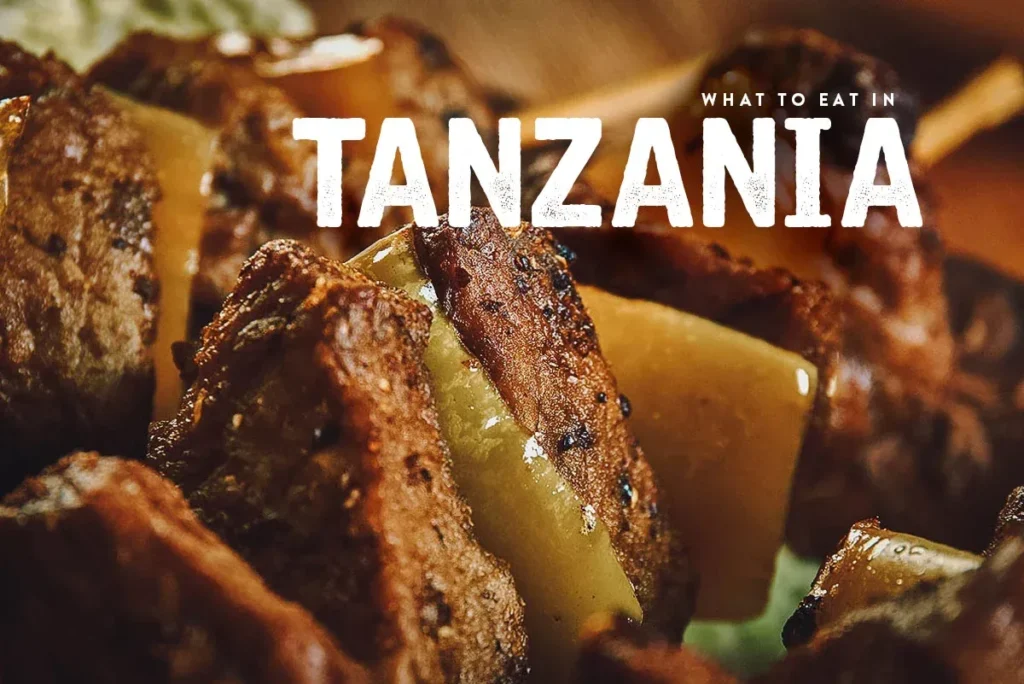
Kenyan and Tanzanian cuisines reflect the rich diversity of cultures and ingredients found in East Africa. Let’s compare and contrast the food of Kenya and Tanzania based on taste, ingredients, popular dishes, and culinary influences.
| Aspect | Kenyan Food | Tanzanian Food |
| Taste | Robust and flavorful, often characterized by spicy and savory dishes. | Rich and aromatic, with a blend of spices creating depth of flavor. |
| Ingredients | Utilizes staples like maize, beans, potatoes, and meat (such as beef, chicken, and goat). | Features ingredients like coconut milk, cassava, plantains, and a variety of spices such as cloves, cinnamon, and cardamom. |
| Popular Dishes | Ugali (maize porridge), nyama choma (grilled meat), samosas, and chapati. | Pilau (spiced rice), ugali, nyama na irio (mashed potatoes and peas with meat), seafood dishes (especially on the coast). |
| Culinary Influences | Influenced by British, Indian, and Arab cuisines due to historical trade and colonial ties. | Influenced by Indian, Arabic, and Portuguese cuisines, along with local Bantu culinary traditions. |
In conclusion, both Kenya and Tanzania offer a delightful array of culinary delights influenced by diverse cultures and ingredients. Kenyan cuisine leans towards hearty and savory dishes, while Tanzanian cuisine boasts rich and aromatic flavors with a mix of spices and tropical ingredients. Exploring the food scenes in both countries can be a delightful adventure for food enthusiasts seeking authentic African flavors.
Best Places To Stay- Accommodation
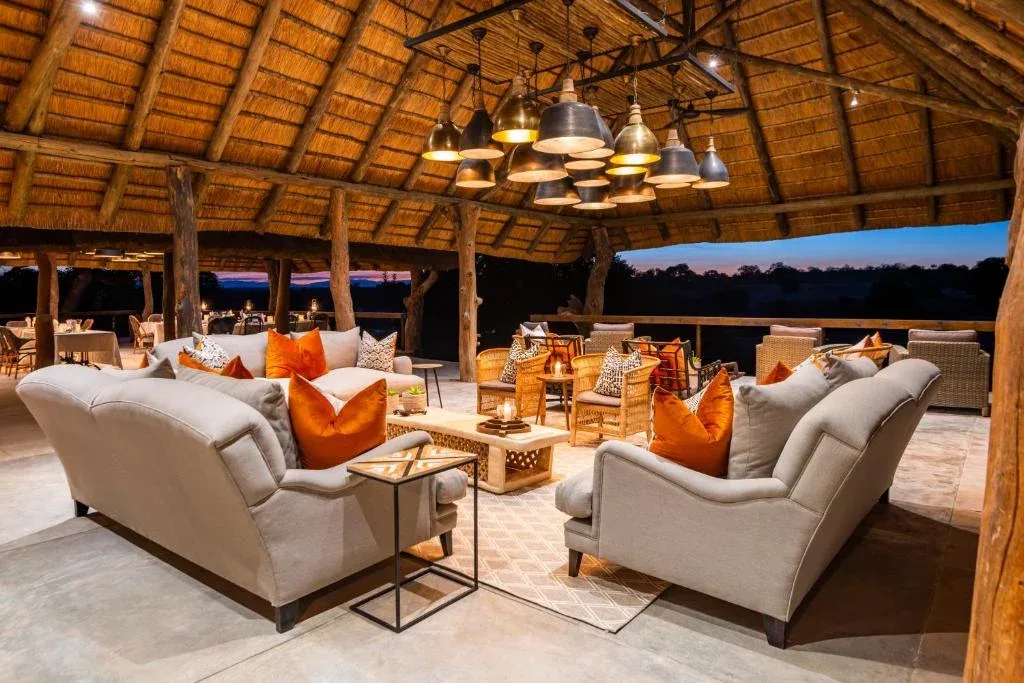
Choosing the best places to stay is crucial for an enjoyable safari experience in Kenya and Tanzania. Let’s compare and contrast some of the top accommodation options in both countries based on factors like location, amenities, and overall experience.
| Aspect | Kenya | Tanzania |
| Location | Olare Motorogi Conservancy in Masai Mara, Amboseli National Park, Diani Beach | Serengeti National Park, Ngorongoro Conservation Area, Zanzibar Island |
| Accommodation | Luxury lodges, tented camps, boutique hotels | Luxury tented camps, lodges, eco-friendly resorts |
| Amenities | Spa services, swimming pools, gourmet dining | Wildlife viewing decks, guided nature walks, cultural interactions |
| Wildlife | Close proximity to Big Five and other wildlife | Direct access to renowned national parks and abundant wildlife sightings |
| Scenery | Spectacular views of savannah, rivers, and wildlife | Vast plains, lush forests, stunning sunsets over the Serengeti and Ngorongoro Crater |
| Experience | Exclusive safari experiences, personalized service | Immersive wilderness experiences, cultural insights, and wildlife conservation initiatives |
Both Kenya and Tanzania offer an array of exceptional places to stay, each providing unique experiences in terms of location, amenities, and wildlife encounters. Whether you prefer the iconic savannah landscapes of Masai Mara or the expansive plains of Serengeti, there are accommodation options tailored to enhance your safari adventure and provide unforgettable memories.
Big 5 Sightings, The Wildebeest Migration & General Game Viewing Safari Activities
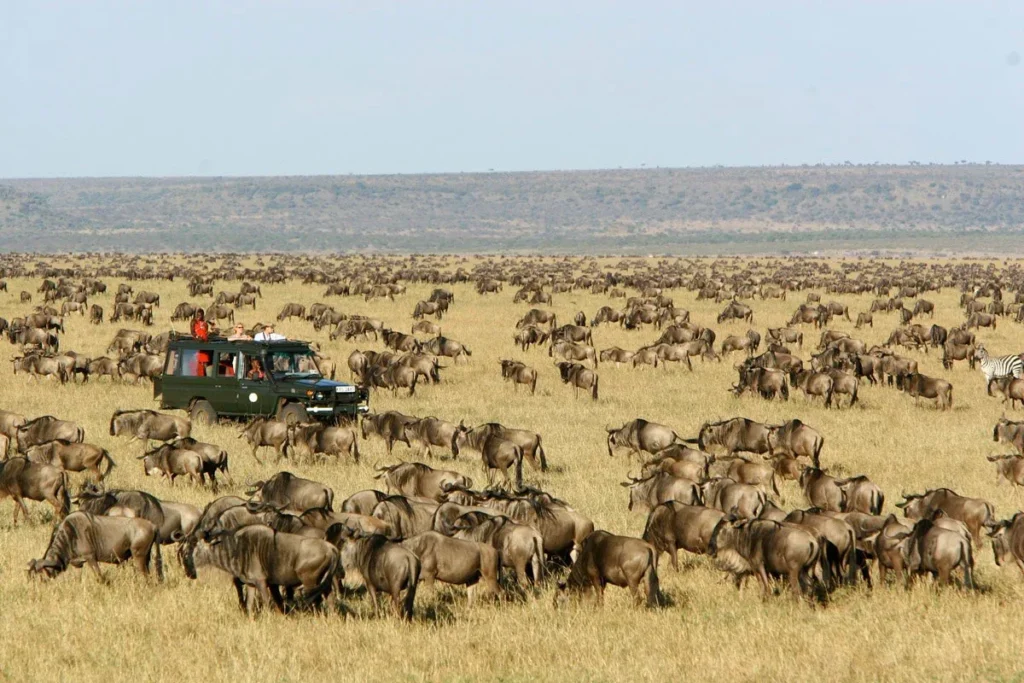
Embarking on a safari in Kenya and Tanzania promises unparalleled wildlife experiences, including sightings of the Big 5, witnessing the Great Wildebeest Migration, and enjoying general game viewing activities. Let’s compare and contrast these safari activities in both countries.
| Aspect | Kenya | Tanzania |
| Big 5 Sightings | Masai Mara National Reserve, Amboseli National Park | Serengeti National Park, Ngorongoro Crater, Tarangire National Park, Manyara Reserve |
| Wildebeest Migration | Masai Mara (July to October) | Serengeti (December to July) |
| General Game Viewing | Diverse habitats including savannah, forests, rivers | Varied landscapes from plains to volcanic craters, abundant wildlife year-round |
| Safari Activities | Game drives, bush walks, hot air balloon safaris | Game drives, walking safaris, cultural visits, hot air balloon rides |
| Crowd Levels | Can be busy during migration season, especially in prime areas | Generally well-distributed crowds across various parks, more secluded options available |
Both Kenya and Tanzania offer incredible safari experiences with unique opportunities for spotting the Big 5, witnessing the Great Wildebeest Migration, and enjoying diverse game viewing activities. The choice between the two destinations depends on factors like preferred timing for specific wildlife events, preferred landscapes, and desired safari activities. Both countries provide unforgettable wildlife adventures for nature enthusiasts and safari-goers alike.
Best Time To Go, Best Suited For and What it Combines Best With .
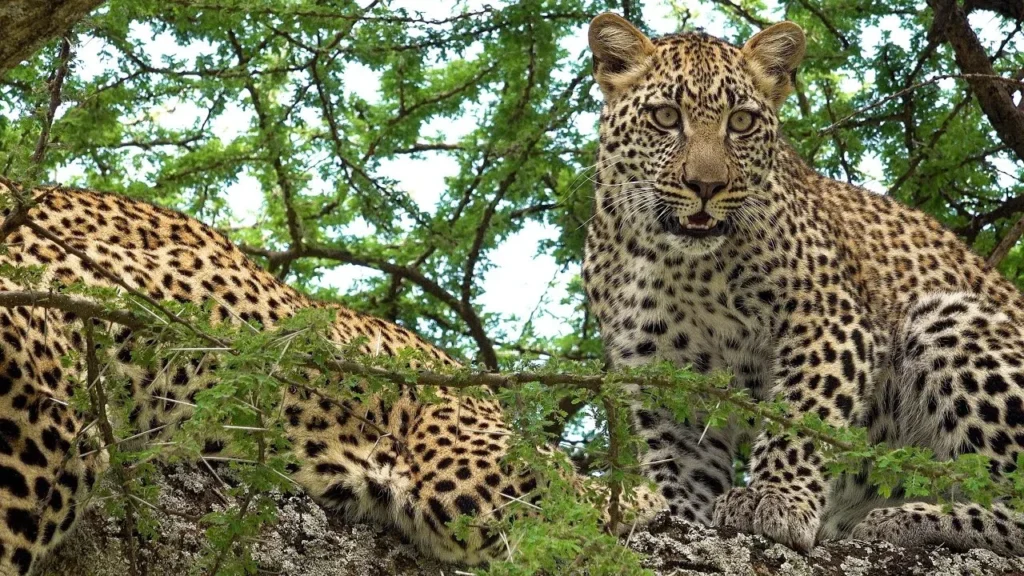
Planning a safari to Kenya or Tanzania involves considering various factors such as the best time to visit, the type of traveler the destination suits best, and what each destination combines best with. Let’s compare and contrast these aspects for safaris in Kenya and Tanzania.
| Aspect | Kenya Safaris | Tanzania Safaris |
| Best Time To Go | July to October (Masai Mara Migration Season) | December to March (Serengeti Migration Season), June to October (General wildlife viewing) |
| Traveller Types | Families, first-time safari-goers, luxury travelers | Wildlife enthusiasts, photographers, budget-conscious travelers |
| Combines Best With | Beach holidays in Diani, Lamu; cultural experiences | Zanzibar beach stay; Mount Kilimanjaro climb; Ngorongoro Crater visit; Lake Victoria tour |
Deciding between a safari in Kenya or Tanzania depends on factors such as the preferred time of travel, the type of traveler, and what additional experiences one seeks to combine with the safari. Kenya’s Masai Mara is ideal for witnessing the migration and is well-suited for families and luxury travelers, while Tanzania’s Serengeti offers diverse wildlife experiences and caters to wildlife enthusiasts and budget-conscious travelers. Both destinations offer opportunities to combine safaris with beach holidays, cultural experiences, and unique adventures, ensuring a memorable African safari experience tailored to different preferences.
Kenya VS Tanzania Safaris, Safari Activities

When planning a safari in Kenya or Tanzania, the range of safari activities offered in national parks and private reserves/conservancies plays a crucial role in the overall experience. Let’s compare and contrast these safari activities in both countries across various categories.
| Aspect | Kenya Safaris | Tanzania Safaris |
| Morning & Afternoon Game Drives | Common in both national parks and private conservancies | Available in national parks and private reserves, guided by experienced rangers |
| Guided Nature Walks | Offered in private conservancies; limited or unavailable in parks | Generally available in private reserves and some national parks |
| Off-road Game Drives | Limited to private conservancies, not allowed in national parks | Allowed in private reserves with experienced guides, restricted in national parks |
| Night Drives | Generally not permitted in most parks and reserves | Available in private conservancies with special permissions, not common in parks |
| Self-driving | Possible in some parks like Masai Mara with certain restrictions | Not recommended due to safety concerns and lack of infrastructure in national parks |
| Tour Groups | Common, with options for both private and group safaris | Offered for group safaris, private tours available for a more personalized experience |
| Access to National Park | Open to public with park fees and regulations | Accessible with park fees and regulations; limited to designated areas |
| Access to Conservancies | Restricted access with permits and guided tours | Open to guests staying in the conservancy, guided experiences provided |
| Vehicle Limit at Sightings | Generally regulated to avoid overcrowding and disturbance | Controlled to ensure minimal impact on wildlife, especially during peak seasons |
| Hot-air Ballooning | Available in Masai Mara with breathtaking views | Offered in Serengeti providing an aerial perspective of the wildlife and landscape |
| Cultural Excursions | Available with visits to local villages and communities | Offers visits to Maasai or other tribes, providing insights into local culture |
| Fly-camping | Limited options, mostly available in private conservancies | Available in certain private reserves, offering immersive bush experiences |
| Chimp or Camel Trekking | Not common in most safari areas | Available in specific regions such as Tarangire for camel trekking |
Both Kenya and Tanzania offer a rich variety of safari activities, each with its unique charm and appeal. Kenya’s private conservancies provide exclusivity and options like guided nature walks and fly-camping, while Tanzania’s national parks like Serengeti allow hot-air ballooning and night drives in private conservancies. The choice of safari activities depends on individual preferences, with both countries promising unforgettable wildlife experiences amidst stunning natural landscapes.
In conclusion, After comparing various aspects of Kenya and Tanzania safaris across different categories, it becomes evident that both countries offer incredible opportunities for an African safari, each with its unique strengths and highlights. Therefore, the choice between Kenya and Tanzania for an African safari depends on individual preferences, travel goals, and budget considerations. Both countries offer incredible wildlife experiences, stunning landscapes, and a rich tapestry of cultures, ensuring an unforgettable safari adventure regardless of the destination chosen. Travelers may consider combining both countries for a comprehensive East African safari experience.
Top of Form

